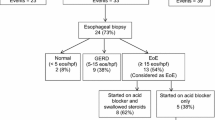Abstract
Background and Aims
Food impaction has been described in both eosinophilic esophagitis and proton pump inhibitor-responsive esophageal eosinophilia. The association between endoscopic/histologic features of esophageal eosinophilia and food impaction remains unclear. We aimed to identify clinical, endoscopic, and histologic findings associated with a history of food impaction in esophageal eosinophilia.
Methods
This was a retrospective cohort study of adult esophageal eosinophilia patients at a tertiary center in 6/2005–10/2014. Only patients with ≥15 eosinophils/high-power field on mucosal biopsies were included. Demographics, comorbidities, symptoms, endoscopic/histologic findings on initial endoscopy, and history of food impaction were reviewed. Statistical analyses were performed using Fisher’s exact test (univariate) and forward stepwise logistic regression (multivariate).
Results
400 patients (42 ± 14 years, 61 % male) were included, with 78 (20 %) having food impaction history. On univariate analyses, rings (62 vs 42 %, p = 0.003), erosions (12 vs 5 %, p = 0.03), eosinophil density on biopsy (40 [IQR = 30–50] vs 30 [IQR = 15–50], p = 0.004), and dysphagia (88 vs 62 %, p < 0.0001) were more prevalent among patients with food impaction history, while heartburn (10 vs 33 %, p < 0.0001) and abdominal pain (1 vs 12 %, p = 0.002) were less common. On multivariate analysis, rings (OR 2.6, p = 0.002), erosions (OR 3.2, p = 0.02), and eosinophil density (β-coefficient = 0.01, p = 0.04) remained associated with food impaction.
Conclusions
Findings of rings and erosions on endoscopy and increased eosinophil density on histology were independently associated with a history of food impaction in adult esophageal eosinophilia patients. Food impaction may result from both active inflammation (erosions and increased eosinophil density) and chronic fibrostenotic changes (rings).

Similar content being viewed by others
References
Dellon ES, Gonsalves N, Hirano I, Furuta GT, Liacouras CA, Katzka DA. ACG clinical guideline: evidenced based approach to the diagnosis and management of esophageal eosinophilia and eosinophilic esophagitis (EoE). Am J Gastroenterol. 2013;108:679–692.
Liacouras CA, Furuta GT, Hirano I, et al. Eosinophilic esophagitis: updated consensus recommendations for children and adults. J Allergy Clin Immunol. 2011;128:3–20.
Dellon ES. Diagnosis and management of eosinophilic esophagitis. Clin Gastroenterol Hepatol. 2012;10:1066–1078.
Desai TK, Stecevic V, Chang CH, Goldstein NS, Badizadegan K, Furuta GT. Association of eosinophilic inflammation with esophageal food impaction in adults. Gastrointest Endosc. 2005;61:795–801.
Straumann A, Bussmann C, Zuber M, Vannini S, Simon HU, Schoepfer A. Eosinophilic esophagitis: analysis of food impaction and perforation in 251 adolescent and adult patients. Clin Gastroenterol Hepatol. 2008;6:598–600.
Dellon ES, Speck O, Woodward K, et al. Clinical and endoscopic characteristics do not reliably differentiate PPI-responsive esophageal eosinophilia and eosinophilic esophagitis in patients undergoing upper endoscopy: a prospective cohort study. Am J Gastroenterol. 2013;108:1854–1860.
Moawad FJ, Schoepfer AM, Safroneeva E, et al. Eosinophilic oesophagitis and proton pump inhibitor-responsive oesophageal eosinophilia have similar clinical, endoscopic and histological findings. Aliment Pharmacol Ther. 2014;39:603–608.
Hiremath GS, Hameed F, Pacheco A, Olive A, Davis CM, Shulman RJ. Esophageal food impaction and eosinophilic esophagitis: a retrospective study, systematic review, and meta-analysis. Dig Dis Sci. 2015;60:3181–3193.
Aceves SS, Newbury RO, Dohil R, Bastian JF, Broide DH. Esophageal remodeling in pediatric eosinophilic esophagitis. J Allergy Clin Immunol. 2007;119:206–212.
Nicodème F, Hirano I, Chen J, et al. Esophageal distensibility as a measure of disease severity in patients with eosinophilic esophagitis. Clin Gastroenterol Hepatol. 2013;11:1101–1107.
Mueller S, Aigner T, Neureiter D, Stolte M. Eosinophil infiltration and degranulation in oesophageal mucosa from adult patients with eosinophilic oesophagitis: a retrospective and comparative study on pathological biopsy. J Clin Pathol. 2006;59:1175–1180.
Vasilopoulos S, Murphy P, Auerbach A, et al. The small-caliber esophagus: an unappreciated cause of dysphagia for solids in patients with eosinophilic esophagitis. Gastrointest Endosc. 2002;55:99–106.
Straumann A, Spichtin HP, Grize L, Bucher KA, Beglinger C, Simon HU. Natural history of primary eosinophilic esophagitis: a follow-up of 30 adult patients for up to 11.5 years. Gastroenterology. 2003;125:1660–1669.
Pasha SF, DiBaise JK, Kim HJ, et al. Patient characteristics, clinical, endoscopic, and histologic findings in adult eosinophilic esophagitis: a case series and systematic review of the medical literature. Dis Esophagus. 2007;20:311–319.
Hudson S, Sampson C, Muntz HR, Jackson WD, Smith ME. Foreign body impaction as presentation of eosinophilic esophagitis. Otolaryngol Head Neck Surg. 2013;149:679–681.
Straumann A, Rossi L, Simon HU, Heer P, Spichtin HP, Beglinger C. Fragility of the esophageal mucosa: a pathognomonic endoscopic sign of primary eosinophilic esophagitis? Gastrointest Endosc. 2003;57:407–412.
Parfitt JR, Gregor JC, Suskin NG, Jawa HA, Driman DK. Eosinophilic esophagitis in adults: distinguishing features from gastroesophageal reflux disease: a study of 41 patients. Mod Pathol. 2006;19:90–96.
Kwiatek MA, Hirano I, Kahrilas PJ, Rothe J, Luger D, Pandolfino JE. Mechanical properties of the esophagus in eosinophilic esophagitis. Gastroenterology. 2011;140:82–90.
Hirano I, Moy N, Heckman MG, Thomas CS, Gonsalves N, Achem SR. Endoscopic assessment of the oesophageal features of eosinophilic oesophagitis: validation of a novel classification and grading system. Gut. 2013;62:489–495.
Hirano I. Therapeutic end points in eosinophilic esophagitis: is elimination of esophageal eosinophils enough? Clin Gastroenterol Hepatol. 2012;10:750–752.
Author contributions
WWC, SM, and AHG initiated study concepts and design; SM, AHG, and JLH contributed to acquisition of data; WWC, SM, AHG, GS, KSH, and RB performed analysis and interpretation of data; WWC, SM, and AHG drafted the manuscript; WWC, SM, AHG, GS, JLH, KSH, and RB contributed to critical revision of manuscript for important intellectual content; WWC, SM, AHG, and GS performed statistical analyses; WWC provided administrative support and overall study supervision.
Author information
Authors and Affiliations
Corresponding author
Ethics declarations
Conflict of interest
The authors have nothing to disclose.
Rights and permissions
About this article
Cite this article
Mangla, S., Goldin, A.H., Singal, G. et al. Endoscopic Features and Eosinophil Density Are Associated with Food Impaction in Adults with Esophageal Eosinophilia. Dig Dis Sci 61, 2578–2584 (2016). https://doi.org/10.1007/s10620-016-4190-6
Received:
Accepted:
Published:
Issue Date:
DOI: https://doi.org/10.1007/s10620-016-4190-6




